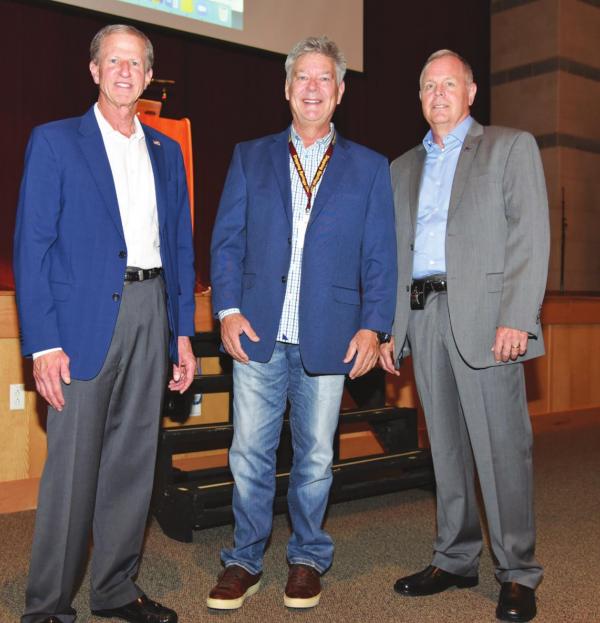Dripping Springs talks school safety
In the wake of the shooting at Ross Elementary in Uvalde, school and law enforcement officials across the country turned their attention to improving school safety and security. Local officials in Dripping Springs were no different.
In a special meeting on June 8, Dripping Springs ISD approved $600,000 to be spent on safety and security improvements for the district. On June 17, the Hays County Precinct 4 Constable's Office, along with the Association of Threat Assessment Professionals, hosted a four-hour training presentation on “School Violence and Mass Casualty Homicide Threat Management,” at Dripping Springs High School. The training presentation was attended by area first responders, mental health professionals, DSISD school staff, local government officials, judges and members of the community.
The district will fund its new safety improvements using unspent funds from the 2018 bond. The recommendation for these improvements was created by the district administration in collaboration with the district’s Safety and Security Committee and evaluated by the district’s Bond Advisory Committee.
“The safety and security of our students and staff is our first and most important priority, and we appreciate the board’s leadership in funding these important measures,” commented Dr. Holly Morris-Kuentz, Superintendent of Dripping Springs ISD.
“The Board of Trustees is committed to continuing to prioritize safety and security through funding initiatives and working to implement security best practices across DSISD,” added Board of Trustees President Dr. Mary Jane Hetrick.
Nine days later, the Constable’s Office hosted its threat-management event, organized by Pct. 4 Deputy Constable David Graham and Jim Savage, a local ATAP member and retired deputy assistant director for the Office of Protective Research in the U.S. Secret Service. Both men have professional experience in active shooter events and their prevention.
Graham is a retired, decorated Dallas Police unit commander who led the unit which was ambushed by Micah Johnson in July 2016, and he was also the tactical incident commander in the June 2015 assault on Dallas Police Headquarters by an armored vehicle.
Savage, in addition to various leadership roles in the U.S. Secret Service, also served on the Vice-Presidential Protective Detail for over four years.
“All of you understand our need to respond quickly and effectively to active shooter scenarios but today, we’re going to talk about the left hand of the equation: prevention,” Savage said. “A whole discipline and structured methodology has evolved in detecting and assessing patterns of behavior that could lead to a mass casualty event.”
The event included presentation content by experts Reid Meloy and Kris Mohandie. Meloy is a board-certified forensic psychologist and consults on criminal and civil cases throughout the U.S. and Europe. Mohandie is a clinical, police, and forensic psychologist with over 30 years’ experience in the assessment and management of violent behavior.
Potentially violent subjects can be detected based on Gestalt psychology and by looking for patterns, according to Meloy. He outlined 8 “proximal warning behaviors” found in most criminals who carry out a mass attack:
1. Pathway — This is the research and planning of an attack, probing the defenses of the building or behavior of people, where they’ll be at certain times of the day.
2. Fixation — This is a strong preoccupation with a person or cause and is found in 81% of all attacks studied. This can also cause deterioration in the subject’s occupational and social life, thereby causing isolation.
3. Identification — The subject strongly identifies with becoming something, like a pseudocommando, important historical figure or celeb rity.
4. Novel Aggression — Some subjects “test” their ability to act aggressively in a particular way and may do “test runs” which are unrelated to their eventual target.
5. Energy Bursts — This involves an increase in activity just before the attack, even if the activity looks innocuous. As the subject’s “on the ground,” real-world activity goes up, the subject’s online and social-media activity goes down.
6. Leakage — The subject communicates (leaks) his intention of causing harm to someone or to some location. This is usually done by boasting to someone in person or posting something on social media. This is a particularly vexing item to law enforcement as it happens 60 to 90% of the time, but also turns out to be a “false positive most of the time.” Nonetheless, law enforcement should follow up on any leakage.
7. Directly Communicated Threat — This is most helpful warning behavior for law enforcement, as the subject tells them directly who or what their target is.
8. Last Resort Behavior — The subject has a deadline by which he must act, either real or perceived. For example, Nidal Hasan, responsible for the November 2009 shooting at Fort Hood, felt he had to act before his deployment to the Middle East, which was scheduled for the following month.
Meanwhile, Mohandie spoke more about the actual police work involved in assessing, recognizing or mitigating a mass homicide incident. He specifically addressed how a police commander should plan security for upcoming events such as protests, VIP visits and potential riots.
DSISD School Board Vice President Ron Jones, who attended the training presentation, said, “The presentation and discussion were extraordinarily insightful-particularly on the topic of threat assessment and risk factors. We’re looking forward to working with our school executive leadership, staff and law enforcement to review all safety and risk protocols to ensure the safety of all our students and staff.”



